CHEVROLET LUMINA 1993 1.G Owners Manual
Manufacturer: CHEVROLET, Model Year: 1993, Model line: LUMINA, Model: CHEVROLET LUMINA 1993 1.GPages: 324, PDF Size: 17.44 MB
Page 231 of 324
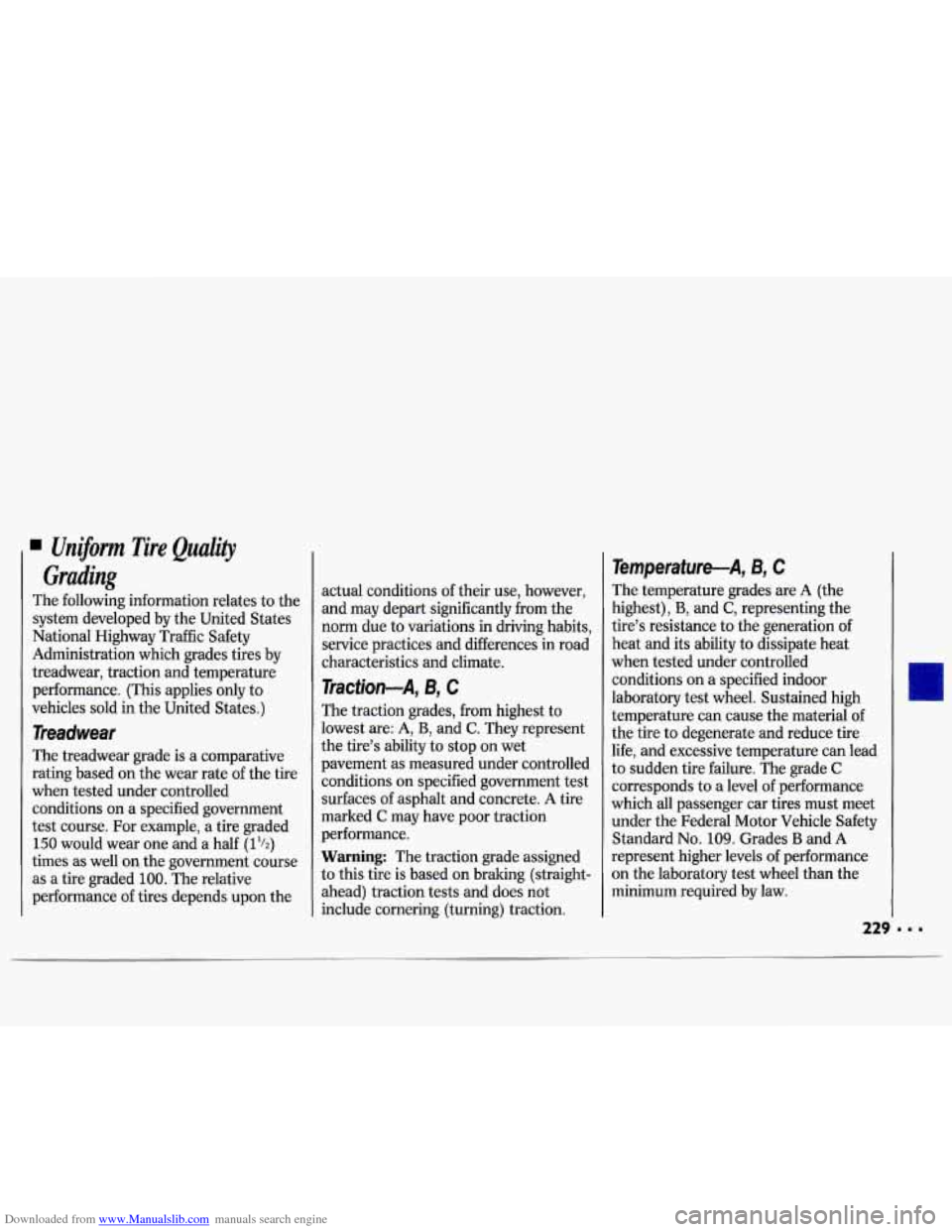
Downloaded from www.Manualslib.com manuals search engine Uniform Tire Quality
Grading
The following information relates to the
system developed by the United States
National Highway Traffic Safety
Administration which grades tires by
treadwear, traction and temperature
performance. (This applies only to
vehicles sold in the United States.)
The treadwear grade is
a comparative
rating based on the wear rate
of the tire
when tested under controlled
conditions on a specified government
test course. For example, a tire graded
150 would wear one and a half (1%)
times as well on the government course
as a tire graded
100. The relative
performance
of tires depends upon the
Treadwear
actual conditions of their use, however,
and may depart significantly
from the
norm due to variations in driving habits,
service practices and differences in road
characteristics and climate.
Traction-A, B, C
The traction grades, from highest to
lowest are: A,
B, and C. They represent
the tire’s ability to stop on wet
pavement as measured under controlled
conditions on specified government test
surfaces of asphalt and concrete. A tire
marked
C may have poor traction
performance.
Warning: The traction grade assigned
to this tire is based on braking (straight-
ahead) traction tests and does not
include cornering (turning) traction.
Temperature-A, B, C
The temperature grades are A (the
highest),
B, and C, representing the
tire’s resistance to the generation of
heat and its ability to dissipate heat
when tested under controlled
conditions on
a specified indoor
laboratory test wheel. Sustained high
temperature can cause the material of
the tire to degenerate and reduce tire
life, and excessive temperature can lead
to sudden tire failure. The grade
C
corresponds to a level of performance
which all passenger car tires must meet under the Federal Motor Vehicle Safety
Standard
No. 109. Grades B and A
represent higher levels of performance
on the laboratory test wheel than the
minimum required by law.
Page 232 of 324
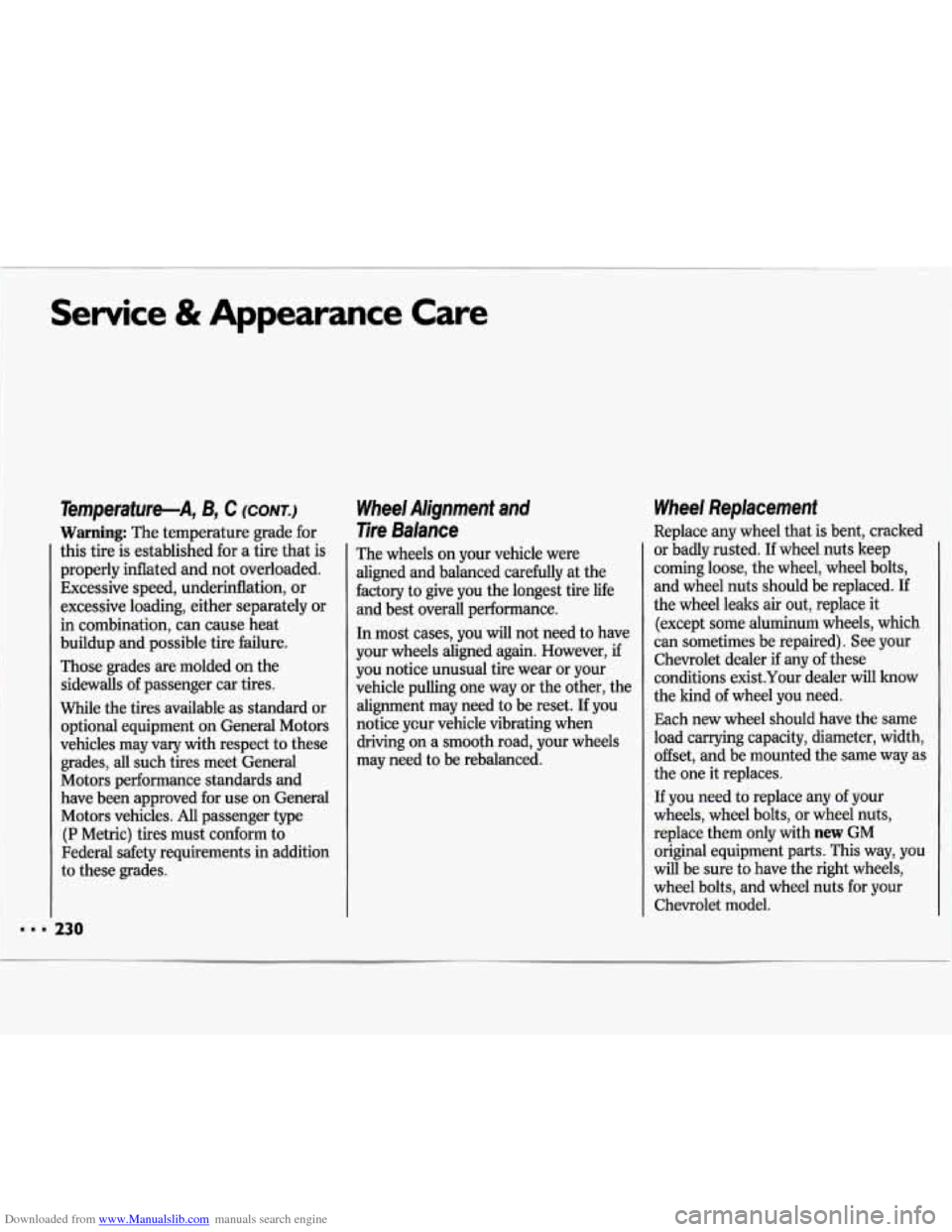
Downloaded from www.Manualslib.com manuals search engine Service & Appearance Care
Temperature-A, B, C (CONT.)
Warning: The temperature grade for
this tire is established for a tire that is
properly inflated and not overloaded.
Excessive speed, underinflation, or
excessive loading, either separately or
in combination, can cause heat
buildup and possible tire failure.
Those grades are molded on the
sidewalls of passenger car tires.
While the tires available as standard or
optional equipment on General Motors
vehicles may vary with respect to these
grades, all such tires meet General
Motors performance standards and
have been approved for use on General
Motors vehicles. All passenger type
(P Metric) tires must conform to
Federal safety requirements in addition
to these grades.
230
Wheel Alignment and
Tire Balance
The wheels on your vehicle were
aligned and balanced carefully at the
factory to give you the longest tire life
and best overall performance.
In most cases, you
will not need to have
your wheels aligned again. However, if
you notice unusual tire wear or your
vehicle pulling one way or the other, the
alignment may need to be reset. If you
notice ycur vehicle vibrating when
driving on a smooth road, your wheels
may need to be rebalanced.
Wheel Replacement
Replace any wheel that is bent, cracked
or badly rusted. If wheel nuts keep
I
coming loose, the wheel, wheel bolts,
and wheel nuts should be replaced. If
the wheel leaks air out, replace
it
(except some aluminum wheels, which
can sometimes be repaired). See your
Chevrolet dealer if any
of these
conditions exist.Your dealer will know
I
the kind of wheel you need.
Each new wheel should have the same
load carrying capacity, diameter, width,
offset, and be mounted the same way
as
the one it replaces.
If you need to replace any
of your
wheels, wheel bolts, or wheel nuts,
replace them only with
new GM
original equipment parts. This way, you
will be sure to have the right wheels,
wheel bolts, and wheel nuts for your
Chevrolet model.
Page 233 of 324
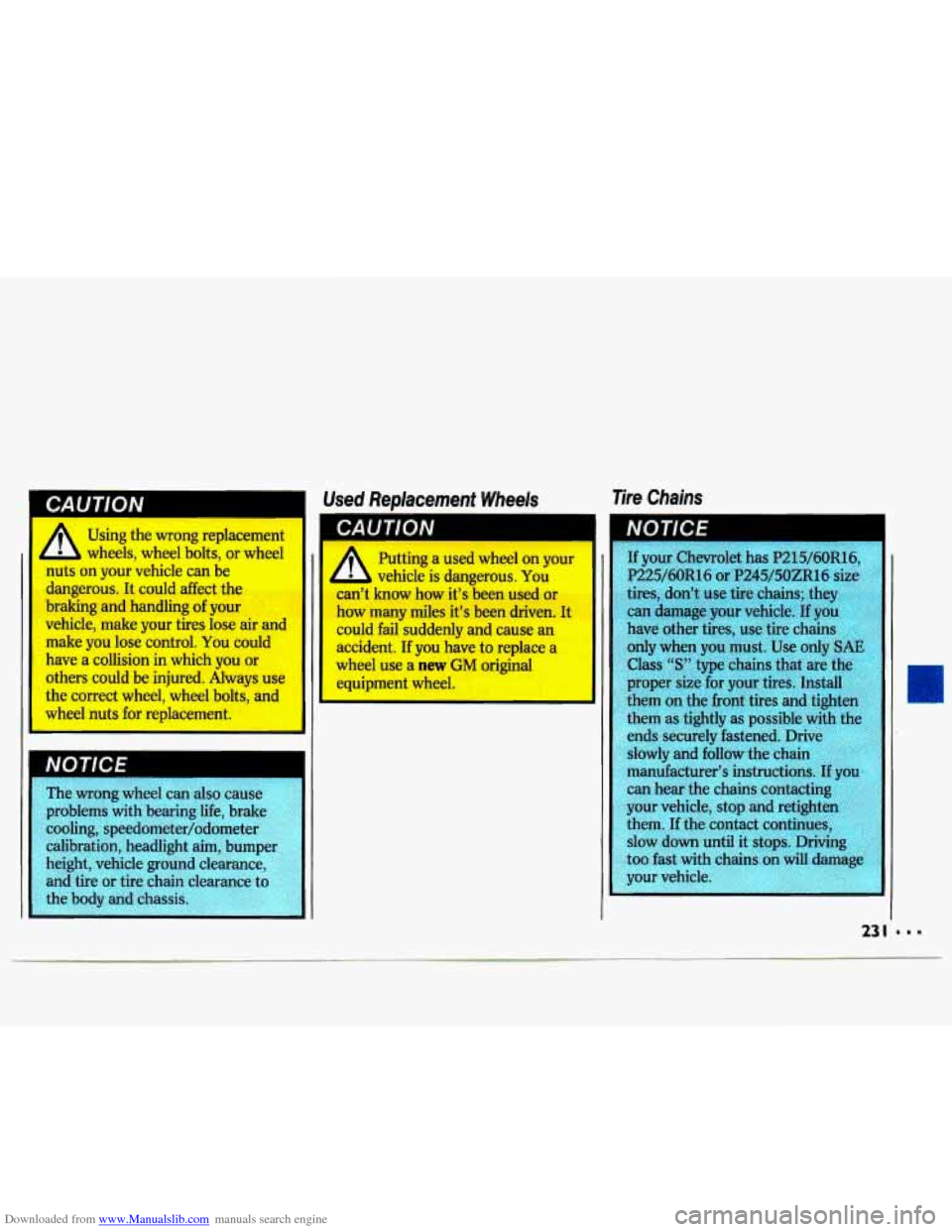
Downloaded from www.Manualslib.com manuals search engine A
Using the wrong replacement
wheels, wheel bolts, or wheel
nuts on your vehicle can be
dangerous. It could affect the
braking and handling
of your
vehicle, make your tires lose air and
make you lose control.
You could
have a collision in which you or
others could be injured. Always use
the correct wheel, wheel bolts, and
wheel nuts for replacement.
-
The wrong wheel can also cause
problems with bearing life, brake
cooling, speedometer/odorneter
calibration, headlight aim, bumper
height, vehicle ground clearance,
and tire or tire chain clearance
to
the body and chassis.
Used Replacement Wheels Tire Chains
Putting a used wheel on your
L vehicle is dangerous. You
can’t know how it’s been used or
how many miles it’s been driven. It could fail suddenly and cause an
accident. If you have to replace a
wheel use a
new GM original
L equiDment wheel.
the
I
’I
Page 234 of 324
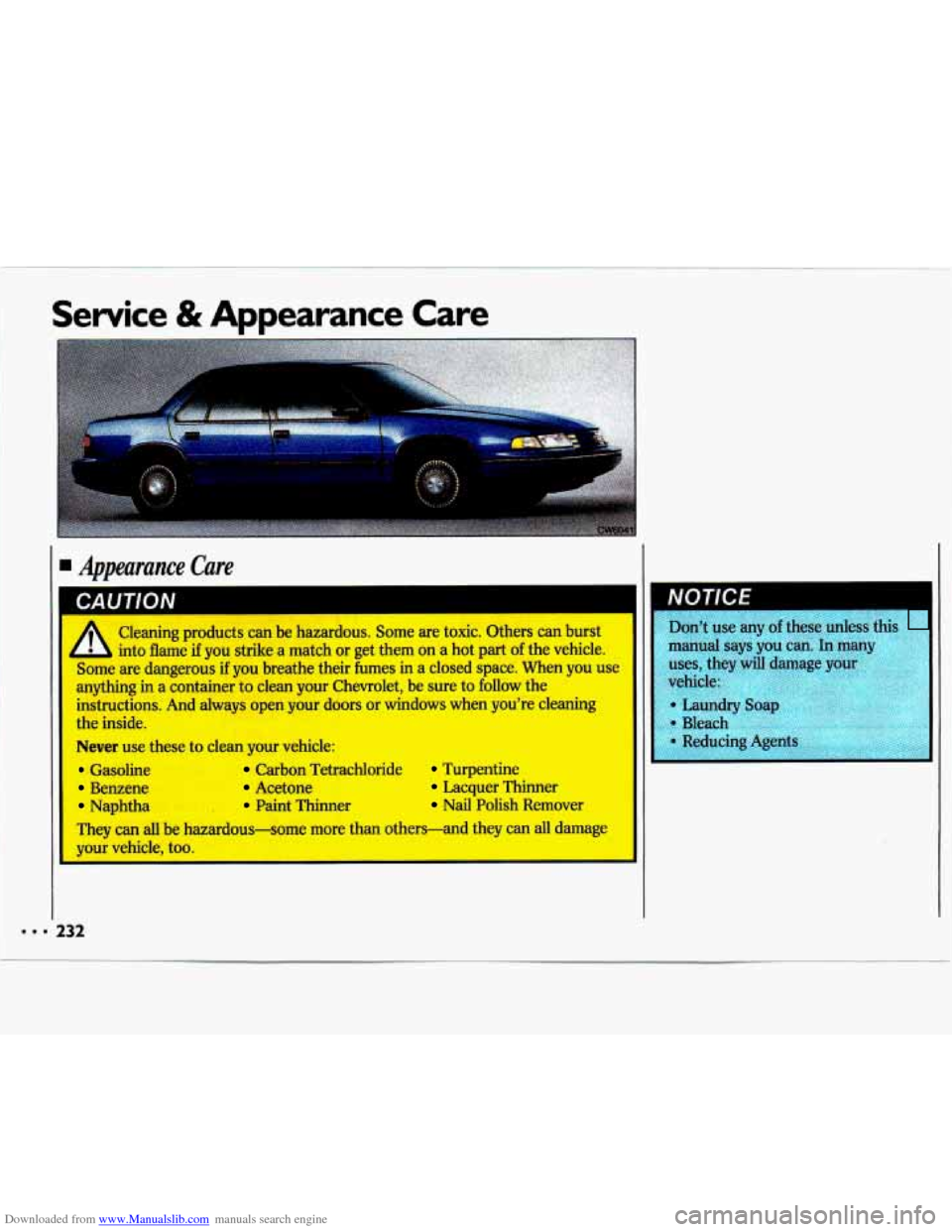
Downloaded from www.Manualslib.com manuals search engine Service & Appearance Care
I Appearance Care
CAUTION
A
Cleaning products can be hazardous. Some are toxic. Others can burst
into flame if you strike a match or get them on a hot part of the vehicle.
Some are dangerous
if you breathe their fumes in a closed space. When you use
anything in a container to clean your Chevrolet, be sure to follow the
I
instructions. And always open your doors or windows when you’\
re cleaning
the inside.
Never use these to clean your vehicle: I
Gasoline Carbon Tetrachloride Turpentine
Benzene Acetone Lacquer Thinner
Naphtha Paint Thinner Nail Polish Remover
They
can all be hazardous-some more than others-and they can all damage
wnllr vphirlp tnn
11 NOTICE
‘Don’t use any of these unless hi^
manual says vou can. In man,
uses, thev v damage vour
vehicl
I
. 232
Page 235 of 324
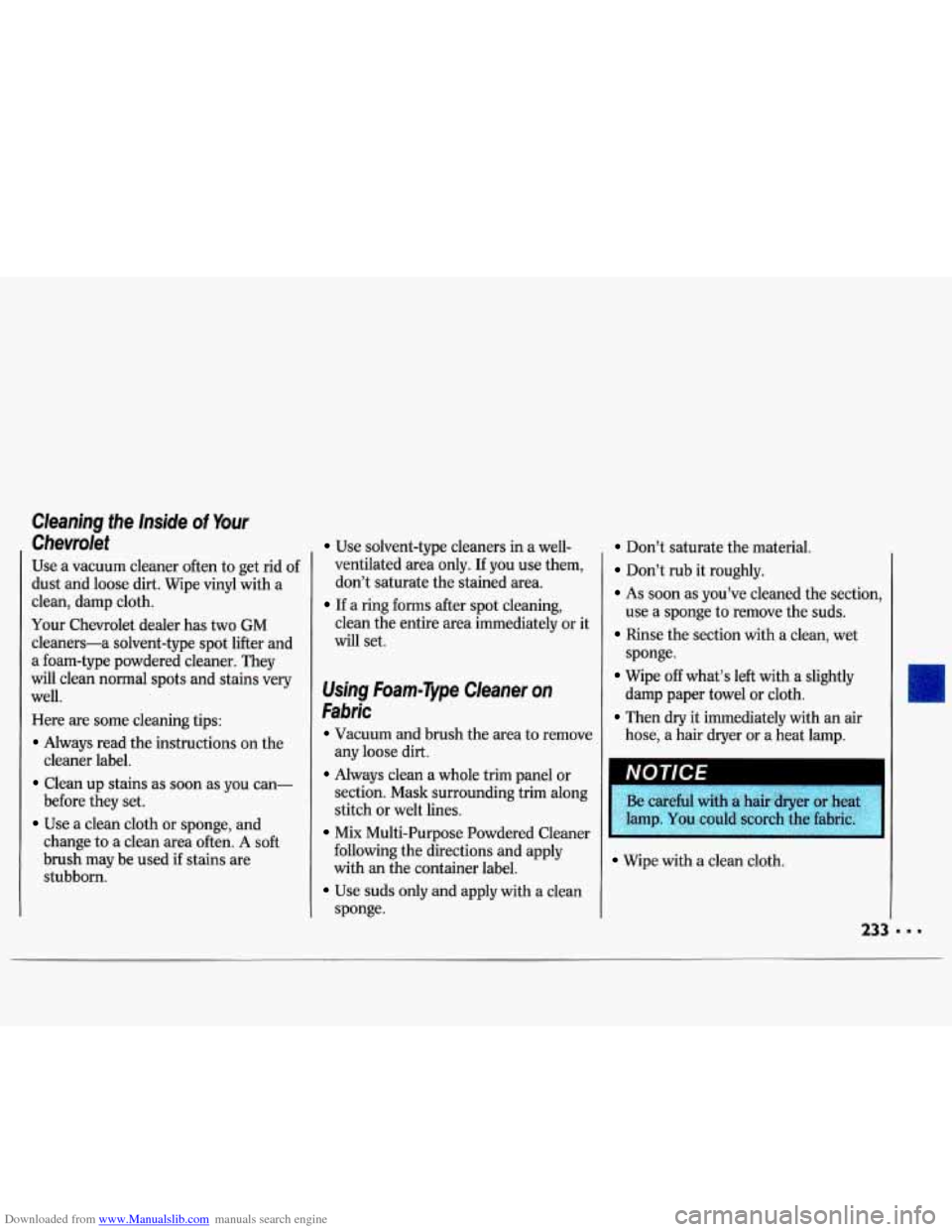
Downloaded from www.Manualslib.com manuals search engine Cleaning the Inside of Your
Chevrolet
Use a vacuum cleaner often to get rid of
dust and loose dirt. Wipe vinyl with a
clean, damp cloth.
Your Chevrolet dealer has two GM
cleaners-a solvent-type spot lifter and
a foam-type powdered cleaner. They
will clean normal spots and stains very
well.
Here are some cleaning tips:
Always read the instructions on the
cleaner label.
Clean up stains as soon as you can-
before they set.
Use a clean cloth or sponge, and
change to a clean area often.
A soft
brush may be used if stains are
stubborn.
Use solvent-type cleaners in a well-
ventilated area only. If you use them,
don’t saturate the stained area.
If a ring forms after spot cleaning,
clean the entire area immediately or it
will set.
Using Foam-Type Cleaner on
Fabric
Vacuum and brush the area to remove
any loose dirt.
Always clean a whole trim panel or
section. Mask surrounding trim along
stitch or welt lines.
Mix Multi-Purpose Powdered Cleaner
following the directions and apply
with an the container label.
Use suds only and apply with a clean
sponge.
Don’t saturate the material.
Don’t rub it roughly.
As soon as you’ve cleaned the section,
use a sponge to remove the suds.
Rinse the section with a clean, wet
sponge.
Wipe off what’s left with a slightly
damp paper towel or cloth.
Then dry it immediately with an air
hose, a hair dryer or a heat lamp.
Wipe with a clean cloth.
Page 236 of 324
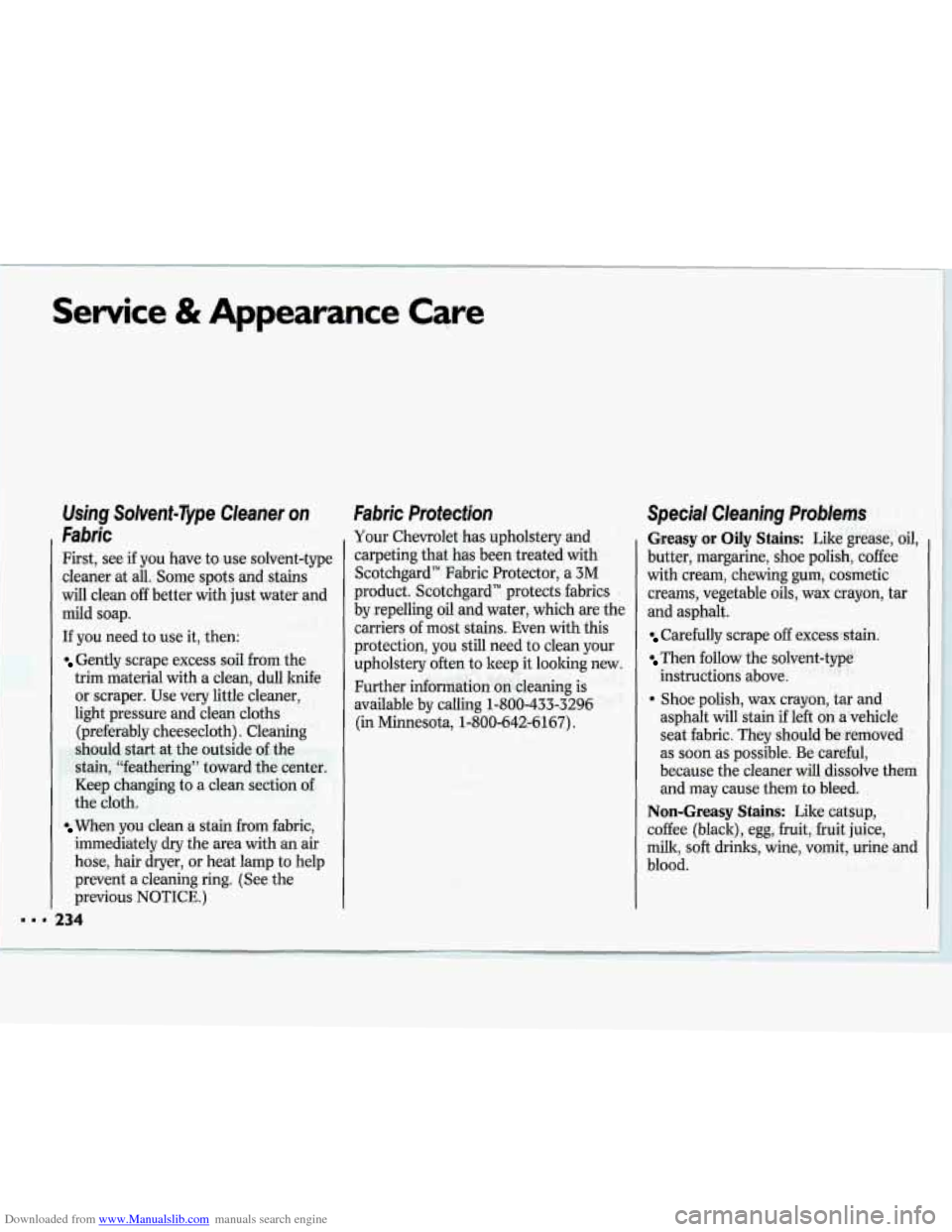
Downloaded from www.Manualslib.com manuals search engine Service & Appearance Care
Using Solvent-Type Cleaner on
Fabric
First, see if you have to use solvent-type
cleaner at all. Some spots and stains
will clean
off better with just water and
mild soap.
If you need to use it, then:
Gently scrape excess soil from the
trim material with a clean, dull knife
or scraper. Use very little cleaner,
light pressure and clean cloths
(preferably cheesecloth). Cleaning
should
start at the outside of the
stain, “feathering” toward the center.
Keep changing to a clean section of
the cloth.
When you clean a stain from fabric,
immediately dry the area with an air
hose, hair dryer, or heat lamp to help
prevent a cleaning ring. (See the
previous NOTICE.)
. 234
Fabric Protection
Your Chevrolet has upholstery and
carpeting that has been treated with
Scotchgard” Fabric Protector, a
3M
product. Scotchgard” protects fabrics
by repelling oil and water, which are the
carriers of most stains. Even with this
protection, you still need to clean your
upholstery often to keep it looking new.
Further information
on cleaning is
available by calling 1-800-433-3296 (in Minnesota, 1-800-642-6167).
Special Cleaning Problems
Greasy or Oily Stains: Like grease, oil,
butter, margarine, shoe polish, coffee
with cream, chewing gum, cosmetic
creams, vegetable oils, wax crayon, tar
and asphalt.
Carefully scrape off excessstain.
Then follow the solvent-typg
. Shoe polish, wax crayon, tar and
instructions
above.
asphalt will stain if left
on a vehicle
seat fabric. They should be removed
as
soon as possible. Be careful,
because the cleaner will dissolve them
and may cause them to bleed.
Non-Greasy Stains: Like catsup,
coffee (black), egg, fruit, fruit juice,
milk, soft drinks, wine, vomit, urine and
blood.
Page 237 of 324
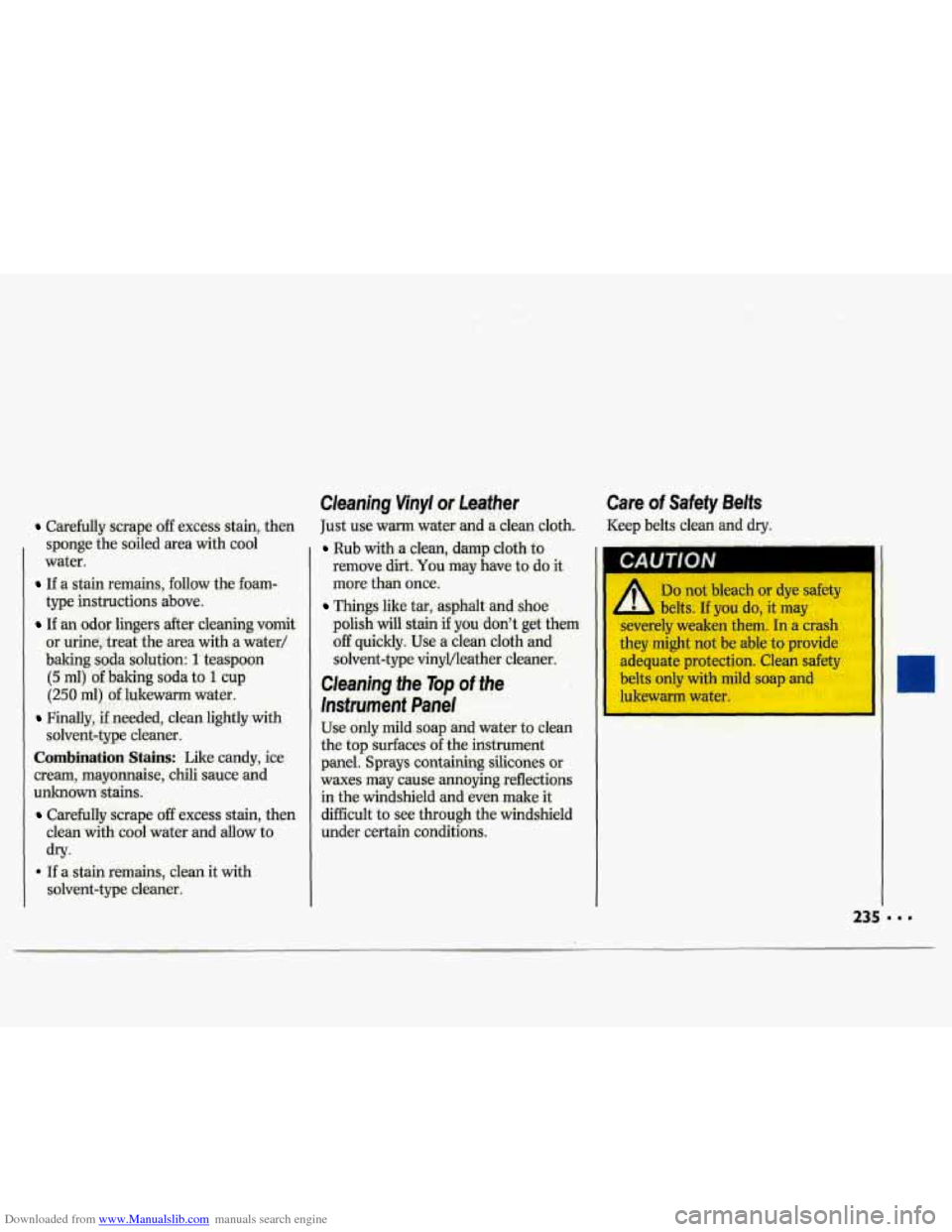
Downloaded from www.Manualslib.com manuals search engine Carefully scrape off excess stain, then
sponge the soiled area with cool
water.
If a stain remains, follow the foam-
type instructions above.
If an odor lingers after cleaning vomit
or urine, treat the area
with a water/
baking soda solution:
1 teaspoon
(5 ml) of baking soda to 1 cup
(250 ml) of lukewarm water.
solvent-type cleaner.
Finally, if needed, clean lightly with
Combination Stes: Like candy, ice
cream, mayonnaise, chili sauce and
unknown stains.
Carefully scrape off excess stain, then
clean with cool water and allow to
dry-
solvent-type cleaner.
* If a stain remains, clean it with
Cleaning Vinyl or Leather Care of Safety Belts
Just use warm water and a clean cloth. Keep belts clean and dry.
Rub with a clean, damp cloth to
remove dirt.
You may have to do it
more than once.
Things like tar, asphalt and shoe
polish will
stain if you don't get them
off quickly. Use a clean cloth and
solvent-type VinyVleather cleaner.
Cleaning the Top of the
lnstrument Panel
Use only mild soap and water to clean
the top surfaces of the instrument
panel. Sprays containing silicones or
waxes may cause
annoying reflections
in the windshield and even make it
difficult to see through the windshield
under certain conditions.
I ca('T'nN
'A
Do not bleach or dye safety
belts. If you do, it may
severely weaken them. In a crash
they might not be able to provide
adequate protection. Clean safety
belts only with mild soap and
lukewarm water.
-
Page 238 of 324
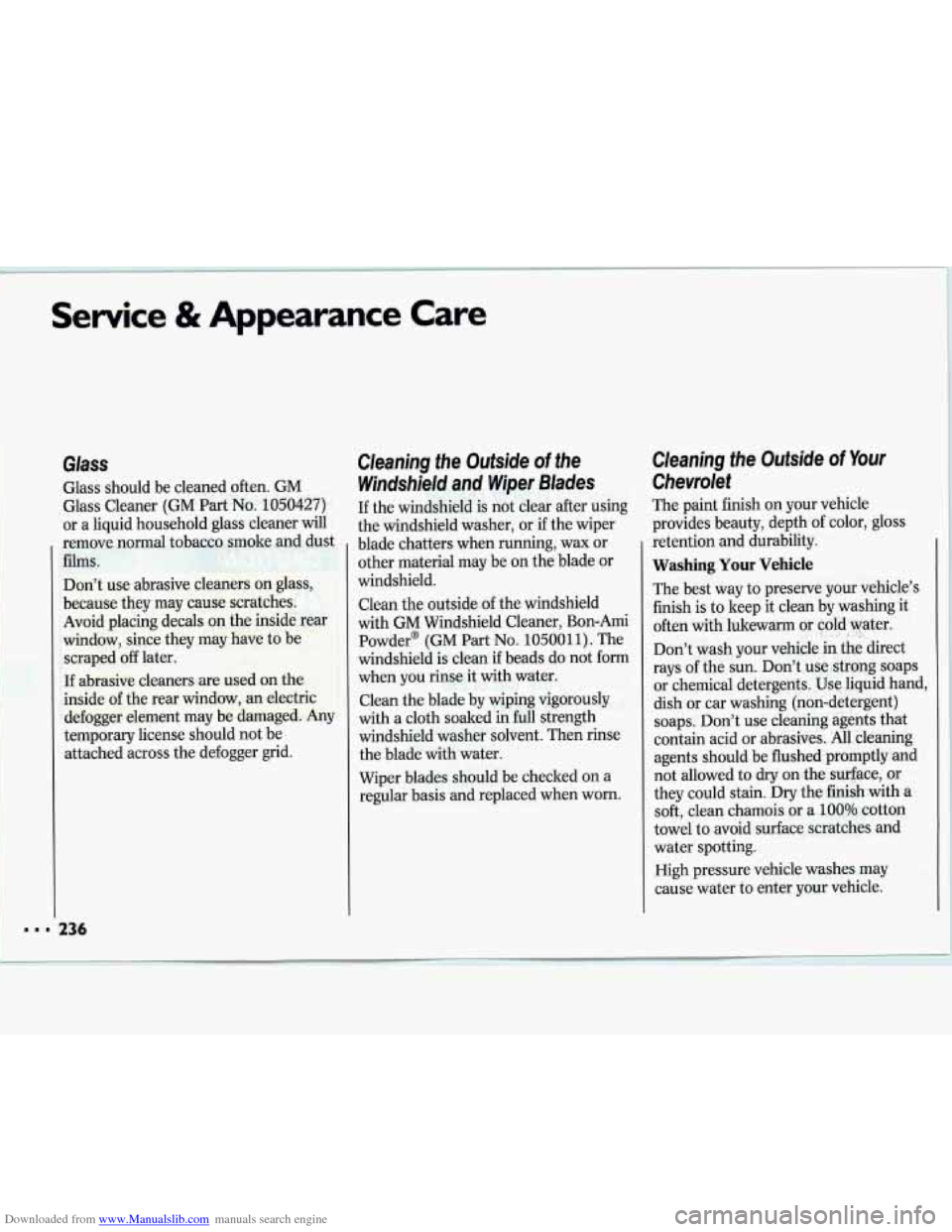
Downloaded from www.Manualslib.com manuals search engine Service & Appearance Care
Glass
Glass should be cleaned often. GM
Glass Cleaner
(GM Part No. 1050427)
or a liquid household glass cleaner will
remove normal tobacco smoke and dust
films.
Don’t use abrasive cleaners on glass,
because they may cause scratches.
Avoid placing decals on the inside rear
window, since they may have to be
scraped off later.
If abrasive cleaners are used on the
inside of the rear window, an electric
defogger element may be damaged. Any
temporary license should not be
attached across the defogger grid.
Cleaning the Outside of the
Windshield and Wiper Blades
If the windshield is not clear after using
the windshield washer, or
if the wiper
blade chatters when running, wax or other material may be on the blade or
windshield.
Clean the outside of the windshield
with GM Windshield Cleaner, Bon-Ami
Powder@
(GM Part No. 1050011). The
windshield is clean
if beads do not form
when you rinse it with water.
Clean the blade by wiping vigorously
with a cloth soaked in
full strength
windshield washer solvent. Then rinse
the blade with water.
Wiper blades should be checked
on a
regular basis and replaced when worn.
Cleaning the Outside of Your
Chevrolet
The paint finish on your vehicle
provides beauty, depth of color, gloss
retention and durability.
Washing Your Vehicle
The best way to preserve your vehicle’s
finish is to keep it clean by washing it
often with lukewarm or cold water.
Don’t wash your vehicle in the direct
rays of the sun. Don’t use strong soaps
or chemical detergents. Use liquid hand,
dish or car washing (non-detergent) soaps. Don’t use cleaning agents that
contain acid or abrasives. All cleaning
agents should be flushed promptly and
not allowed to dry on the surface, or
they could stain. Dry the finish with a
soft, clean chamois or a 100% cotton
towel
to avoid surface scratches and
water spotting.
High pressure vehicle washes may
cause water
to enter your vehicle.
Page 239 of 324
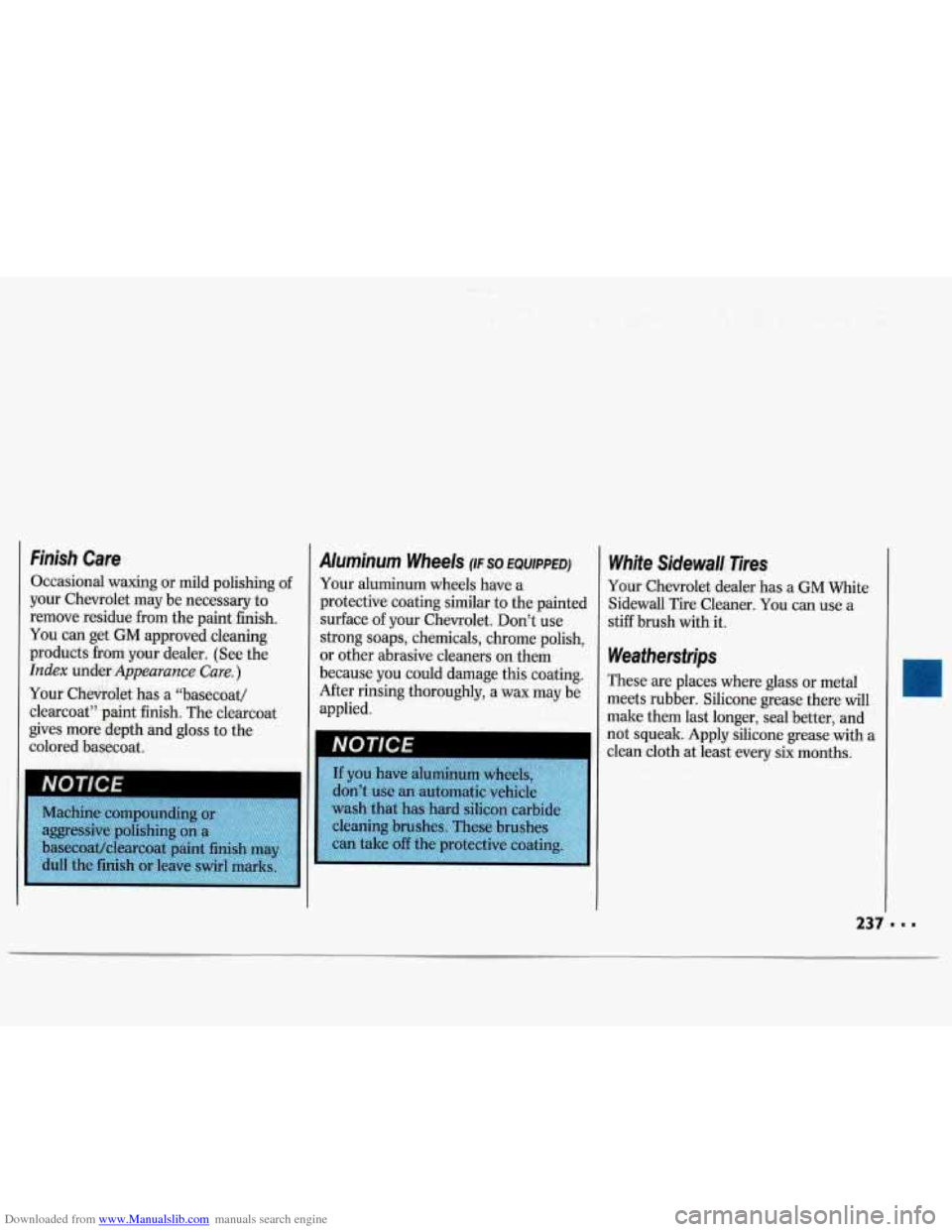
Downloaded from www.Manualslib.com manuals search engine Finish Care
Occasional waxing or mild polishing of
your Chevrolet may be necessary to
remove residue from the paint finish.
You can get
GM approved cleaning
products
from your dealer. (See the
Index under Appearance Care.)
Your Chevrolet has a “basecoat/
clearcoat” paint finish. The clearcoat
gives more depth and gloss to the
colored basecoat.
Aluminum Wheels (IF so EQuwmj
Your aluminum wheels have a
protective coating similar to the painted
surface
of your Chevrolet. Don’t use
strong soaps, chemicals, chrome polish,
or other abrasive cleaners
on them
because you could damage this coating.
After rinsing thoroughly, a wax may be
applied.
If you have aluminum wheels,
don’t use an automatic vehicle
wash that has hard silicon carbide
cleaning brushes. These brushes
can take
off the protective coatin
White Sidewall Tires
Your Chevrolet dealer has a GM White
Sidewall Tire Cleaner. You can use a
stiff brush with it.
Weatherstrips
These are places where glass or metal
meets rubber. Silicone grease there will
make them last longer, seal better, and
not squeak. Apply silicone grease with a
clean cloth at least every six months.
237 .
Page 240 of 324
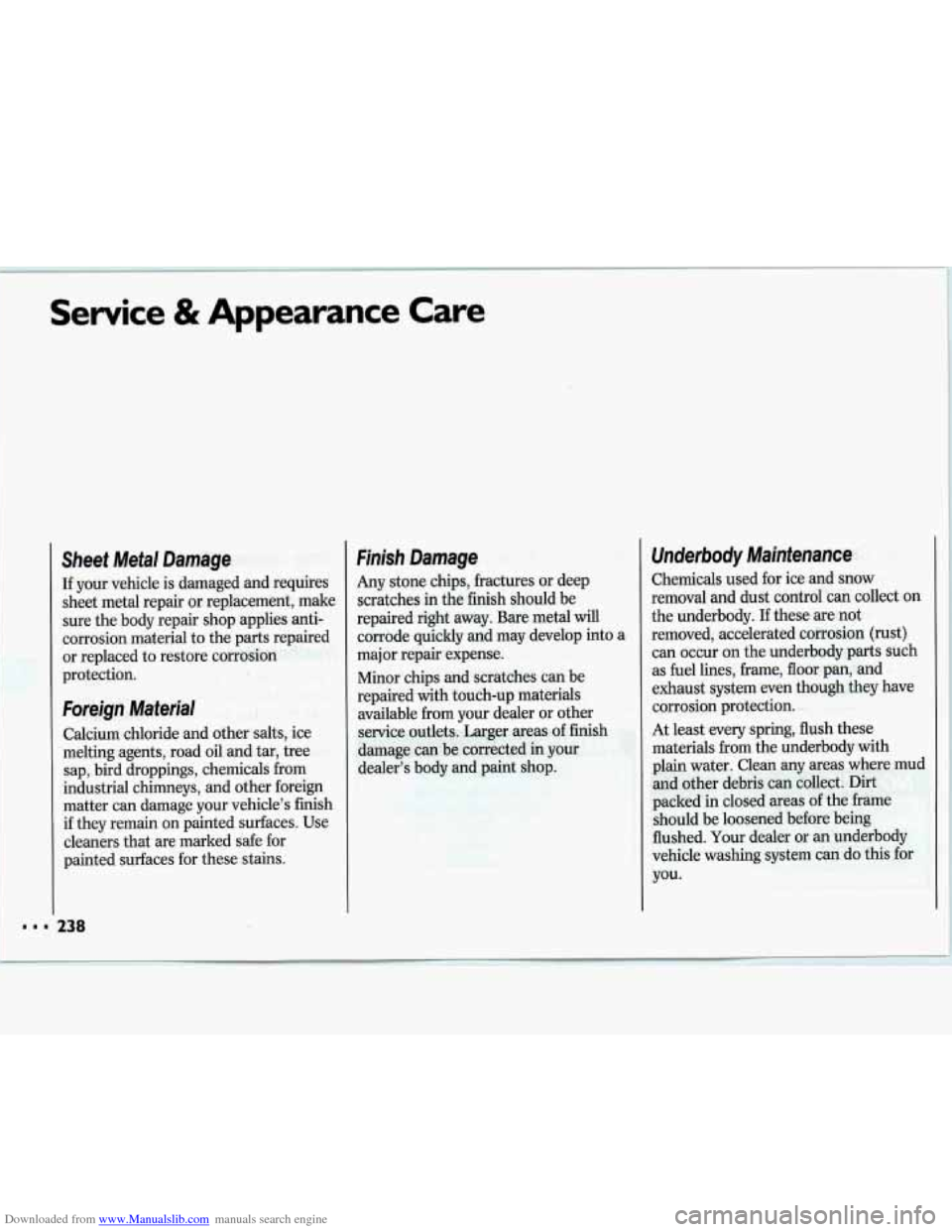
Downloaded from www.Manualslib.com manuals search engine Service & Appearance Care
Sheet Metal Damage
If your vehicle is damaged and requires
sheet metal repair or replacement, make
sure the body repair shop applies anti-
corrosion material to the parts repaired
or replaced to restore corrosion
protection.
Foreign Material
Calcium chloride and other salts, ice
melting agents, road oil and tar, tree
sap, bird droppings, chemicals from
industrial chimneys, and other foreign
matter can damage your vehicle’s finish
if they remain on painted surfaces. Use
cleaners that are marked safe for
painted surfaces for these stains.
238
Finish Damage
Any stone chips, fractures or deep
scratches in the finish should be
repaired right away. Bare metal will
corrode quickly and may develop into a
major repair expense.
Minor chips and scratches can be
repaired with touch-up materials
available from your dealer or other service outlets. Larger areas of finish
damage can be corrected in your
dealer’s body and paint shop.
Underbody Maintenance
Chemicals used for ice and snow
removal and dust control can collect on
the underbody. If these are not
removed, accelerated corrosion
(rust)
can occur on the underbody parts such
as fuel lines, frame, floor pan, and
exhaust system even though they have
corrosion protection.
At least every spring, flush these
materials from the underbody with
plain water. Clean any areas where mud
and other debris can collect. Dirt
packed in closed areas of the frame
should be loosened before being
flushed. Your dealer or an underbody
vehicle washing system can do this for
you.